Related Research Articles

Michael Swanwick is an American fantasy and science fiction author who began publishing in the early 1980s.
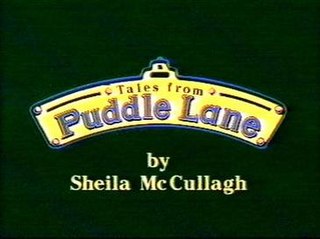
Puddle Lane is a 1980s English pre-school children's television programme written by Rick Vanes with animated stories written by Sheila K. McCullagh, author of Tim and the Hidden People. A long series of early readers based on the stories was produced by Ladybird Books, also under the title Puddle Lane.
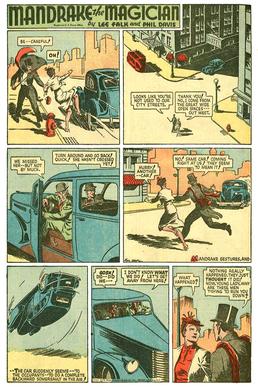
Mandrake the Magician is a syndicated newspaper comic strip, created by Lee Falk before he created The Phantom. Mandrake began publication on June 11, 1934. Phil Davis soon took over as the strip's illustrator, while Falk continued to script. The strip was distributed by King Features Syndicate.

The All-Star Squadron is a DC Comics superhero team that debuted in Justice League of America #193 and was created by Roy Thomas, Rich Buckler and Jerry Ordway. Although the team was introduced in the 1980s, its self-titled series took place in the 1940s, retroactively inserting their narratives into the fictional history of the DC Comics superheroes. The team included many of DC's Golden Age era characters, new characters, and other World War II superheroes that DC did not own during the 1940s but later acquired. The name "All-Star Squadron" was creator Roy Thomas' reference to All Star Comics, the series that introduced the Justice Society of America, the first comic book superhero team.
Barbara Hambly is an American novelist and screenwriter within the genres of fantasy, science fiction, mystery, and historical fiction. She is the author of the bestselling Benjamin January mystery series featuring a free man of color, a musician and physician, in New Orleans in the antebellum years. She also wrote a novel about Mary Todd Lincoln.
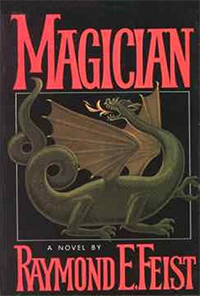
Magician is a fantasy novel by American writer Raymond E. Feist. It is the first book of the Riftwar Saga and of the wider Riftwar Cycle. Magician was originally published in 1982. The book is set in a Dungeons & Dragons–style fantasy world called Midkemia, originally invented by Feist and his friends during college. The story follows the early life of friends Pug and Tomas as their world is overtaken by war against alien invaders who appear via portals.
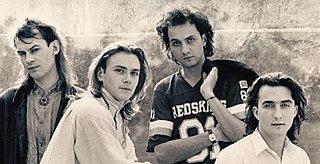
The Bolshoi were an English London-based music group prominent mostly in the mid to late 1980s. They are best known for the hits "Sunday Morning" and "A way" or "Away".

Merrion Frances Fox AM is an Australian writer of children's books and an educationalist specialising in literacy. Fox has been semi-retired since 1996, but she still gives seminars and lives in Adelaide, South Australia.
The Conan books are sword and sorcery fantasies featuring the character of Conan the Cimmerian originally created by Robert E. Howard. Written by numerous authors and issued by numerous publishers, they include both novels and short stories, the latter assembled in various combinations over the years by the several publishers. The character has proven durably popular, resulting in Conan stories being produced after Howard's death by such later writers as Poul Anderson, Leonard Carpenter, Lin Carter, L. Sprague de Camp, Roland J. Green, John C. Hocking, Robert Jordan, Sean A. Moore, Björn Nyberg, Andrew J. Offutt, Steve Perry, John Maddox Roberts, Harry Turtledove, and Karl Edward Wagner. Some of these writers finished incomplete Conan manuscripts by Howard, or rewrote Howard stories which originally featured different characters. Most post-Howard Conan stories, however, are completely original works. In total, more than fifty novels and dozens of short stories featuring the Conan character have been written by authors other than Howard. This article describes and discusses notable book editions of the Conan stories.

Robert Arthur Leeson was an English author, mainly known for his children's books. Before becoming a writer, he worked as Literary Editor of the left-wing British newspaper the Morning Star.
Sheila Kathleen McCullagh MBE was a British author of children's literature.
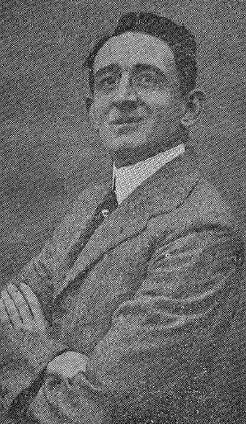
Charles Fulton Oursler Sr. was an American journalist, playwright, editor and writer. Writing as Anthony Abbot, he was an author of mysteries and detective fiction. His son was the journalist and author Will Oursler (1913–1985).
The Riftwar Cycle is the name given to the series of books authored or co-authored by Raymond E. Feist that revolve around the fantasy worlds of Midkemia and Kelewan.
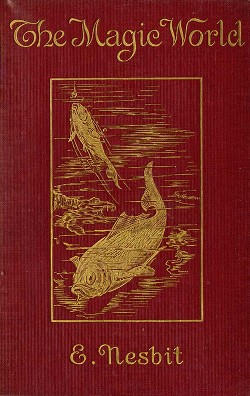
The Magic World is a collection of twelve short stories by E. Nesbit. It was first published in book form in 1912 by Macmillan and Co. Ltd., with illustrations by H. R. Millar and Gerald Spencer Pryse. The stories, previously printed in magazines such as Blackie's Children's Annual, are typical of Nesbit's arch, ironic, clever fantasies for children.
Diana Wynne Jones was a British writer of fantasy novels for children and adults. She wrote a small amount of non-fiction.
Kelly Barnhill is an American author of children's literature, fantasy, and science fiction. Her novel The Girl Who Drank the Moon was awarded the 2017 Newbery Medal. Kirkus Reviews named When Women Were Dragons one of the best science fiction and fantasy books of 2022.

Harrowing the Dragon is a collection of fantasy short stories by Patricia A. McKillip. It was first published in hardcover and ebook by Ace Books in November 2005, and in trade paperback by the same publisher in November 2006. The first British edition was issued in ebook by Gateway/Orion on December 17, 2015.
References
- 1 2 "Fantasy world of Puddle Lane, but rewards are real". Leicester Mercury . 1985-09-30. Archived from the original on 2024-02-04. Retrieved 2024-02-04– via Newspapers.com.
- ↑ Hammerton, Geoff (1985-09-23). "Magic approach has them reading early". Derby Evening Telegraph . Archived from the original on 2024-02-04. Retrieved 2024-02-04– via Newspapers.com.
- 1 2 "New books aim to stem teaching cutbacks". Loughborough Echo . 1985-08-30. Archived from the original on 2024-02-04. Retrieved 2024-02-04– via Newspapers.com.
- ↑ "Trip down Puddle Lane". The Bookseller . No. 5218. 2006-02-24. p. 9. EBSCOhost 20214617.
- ↑ Ashworth, Linda (April 1986). "Reviews: Puddle Lane". Child Education. Vol. 63, no. 4. ISSN 0009-3947 . Retrieved 2024-02-04– via Internet Archive.
- ↑ Dakin, Bridget (1985-09-13). "Open a page to walk down Puddle Lane". Loughborough Echo . Archived from the original on 2024-02-04. Retrieved 2024-02-04– via Newspapers.com.
- ↑ Root, Betty (1986-03-21). "Alive and well and living in schools. Reports of the death of reading schemes are extremely premature, says Betty Root, who looks at some new examples". The Times Educational Supplement . Retrieved 2024-02-04– via Internet Archive.
- ↑ Root, Betty (1986). In Defence of Reading Schemes. Reading: Reading and Language Information Centre. University of Reading. p. 8. ISBN 0-7049-0366-0 . Retrieved 2024-02-04– via Internet Archive.